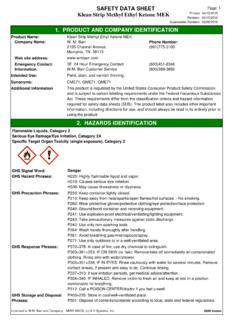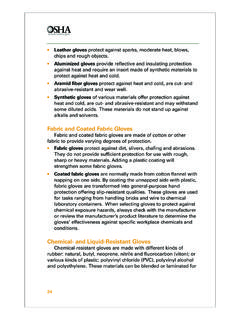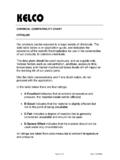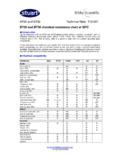Transcription of Physicochemical properties of PET resins - …
1 Physical properties of PET resins 1. Intrinsic Viscosity (IV). Intrinsic viscosity (IV) is a measure of polymer molecular weight , which in turn is a measure of the mechanical strength capability of the material. It is used by most PET producers to control their polymerization processes, to assist end users in the selection of polymers for specific applications and by converters to control their drying and injection molding processes. Generally, if an application requires high strength, a high IV is required whereas lower IV polymer is suitable for end uses where the strength of the container is not the critical factor or where it is desirable that degradation during extrusion is minimized.
2 Product range starts from low molecular weight resins (IV dl/g low limit) and ends to high-high molecular weight resins with an IV more than dl/g, covering all possible requirements for each application. 2. Color coordinates L*, a*, b*. Color can be measured, in resin, preform and bottle, using appropriate color meters, according to CIE- Lab system. It can be analyzed in three coordinates L*, a*, b*(figure 1.). The color coordinate L * measures lightness and varies from 100 for perfect white to zero for black. The color coordinate a* measures redness when plus, gray when zero and greenness when minus. The color coordinate b* is a measure of the yellowness (when in positive values) or the blueness (when in negative values), of the PET chips.
3 PET chips will start to have a slightly yellowish color if b* exceeds the value of 3, and consequently the produced preform and bottle will be yellowish too. PET chips are supplied with a guaranteed b* value of less than An increase in b* value can be a sign of thermal or oxidative degradation during drying or melting. L*=100. +b*. L*=50. -a* + a*. -b*. L*=0. Figure 1. 3. Acetaldehyde Acetaldehyde (AA) is formed by the thermal degradation of PET at the high temperatures that polymer experiences during melt process. It can also be formed during drying with extremely hot air. It is not formed in any other processing ( stretch blow molding). The AA concentration measured in the resin or the preform is the sum of the residual AA and the released AA under the analysis conditions applied to the sample ( 60 min at 150 degC).
4 By applying different time and temperature conditions, different values may be obtained. It is generally advisable to use more intense analysis conditions in order to get a result which is more representative for the total shelf life of the bottle and its content. The levels of AA in a PET bottle do not constitute a health hazard. The only concern is modifying the taste, especially of neutral tasting product such as mineral water. Polisan PET chips are supplied with a very low level of AA guaranteed < ppm and typically <<1 ppm- because most of the AA generated in melt phase polymerization is removed in Solid State Polycondensation. It is very important that AA generation at injection molding is minimized by optimum processing conditions.
5 4. Moisture PET is an inherently hydroscopic material .In PET the moisture is not only on the surface but diffuses slowly through the whole granule and is firmly held by molecular attraction. This moisture must be removed before processing the PET, during drying. Any water present in the injection molding process will cause strong hydrolytic degradation of PET. which result in a significant IV loss followed by a loss of process control and reductions in end . product properties (figure 2.). PET chips are supplied with a humidity content always less than or 2000ppm. Suitable drying parameters must be applied in order to reduce it down to 50 ppm, prior to injection. They have to be the mildest possible in order to minimize thermal and oxidative degradation which increases acetaldehyde level, reduces molecular weight causing discoloration.
6 IV DROP .vs. RETAINED MOISTURE. Initial IV 0,90. 0,1. 0,09 Initial IV 1,00. Initial IV 0,80. 0,08. IV Drop in Melt ( 285 deg C ). 0,07. Initial IV 0,70. 0,06. 0,05. 0,04. 0,03. 0,02. 0,01. 0. 0 25 50 75 100 125 150 175 200. Retained m oisture ppm Figure 2. 5. Melting behavior Crystalline PET fusion, takes place not at specific temperature but over a range of temperatures .It exhibits peak temperatures where melting occurs at the highest rate. PET chip, as it is determined by laboratory method, starts melting at around 215-220 deg C and completes melting at around 255 degC, presenting a peak temperature at 248 deg C (figure 10.). The most important is the chip-to chip melting behavior, which is extremely consistent, allowing the use of the lowest possible temperatures during injection molding.
7 Figure 3. 6. Chemical resistance PET resin presents an inherent resistant to chemical attack .There are ,however, certain chemicals which will attack PET , either chemically to cause loss of clarity, dissolution or physically by causing stress cracking. Below is a list of chemicals whose effect on PET has been evaluated. Chemical resistance data are for storage at room temperature of the substance in the physical state that is specified in the relevant column. When a percentage is indicated, it refers to the concentration of a solution in water, unless otherwise indicated. The meaning of the symbols for chemical resistance is: 1 = PET exhibits good resistance to attack; chances of successful testing are very good.
8 2 = PET has marginal resistance to attack; significant chance of container failure. 3 = PET exhibits poor resistance to attack; should not be considered for this application. The below data reflect the information available to the PET producers. They should not be construed as implying a legal guarantee for specific properties of the products or for their suitability for a particular application. Physical state PET. Substance or concentration producers Acetic Acid 1-10% 1. 10-40% 2. > 40% 3. Acetic Anhydride pure (liquid) 3. Acetone pure (liquid) 3. Aliphatic Hydrocarbons liquid 1. Allyl Alcohol pure (liquid) 1. Ammonium Hydroxide >10% 3. Amyl Acetate pure (liquid) 2. Amyl Alcohol pure (liquid) 2.
9 Amyl Methyl Ketone pure (liquid) 2. Aniline pure (liquid) 3. Aqua Regia liquid 3. Benzene pure (liquid) 3. Benzyl Acetate pure (liquid) 3. Benzyl Alcohol pure (liquid) 3. Benzyl Benzoate pure (liquid) 2. Bromine pure (liquid) 3. Butane pure (liquid) 1. Butyl Acetate pure (liquid) 3. Butyl Alcohol pure (liquid) 2. Physical state PET. Substance or concentration producers Butyl Lactate pure (liquid) 1. Butyl Stearate pure (liquid) 1. Calcium Chloride 10% 1. Carbon Disulphide pure (liquid) 1. Carbon Tetrachloride pure (liquid) 1. Chlorobenzene pure (liquid) 3. Chloroform pure (liquid) 3. Chromic Acid 1-10% 1. 10-40% 2. > 40% 3. Citric Acid 10% 1. Citronellol pure (liquid) 1. Cyclohexane pure (liquid) 1.
10 Cyclohexanol pure (liquid) 1. Cyclohexanone pure (liquid) 3. Di (2 -Ethylhexyl) Phthalate pure (liquid) 1. Diacetone Alcohol pure (liquid) 1. 1,2-Dibromoethane pure (liquid) 3. Dibutyl Phthalate pure (liquid) 1. Dibutyl Sebacate pure (liquid) 1. o-Dichlorobenzene pure (liquid) 3. 1,2-Dichloroethane pure (liquid) 3. Diethyl Ether pure (liquid) 1. Diethylene Glycol pure (liquid) 1. Diethylketone pure (liquid) 3. Dimethyl Formamide pure (liquid) 3. Dinonyl Phthalate pure (liquid) 1. Dioctyl Phthalate pure (liquid) 1. Dioxane pure (liquid) 3. Dipentene pure (liquid) 1. Ethanol See Ethyl Alcohol 2-Ethoxy Ethanol pure (liquid) 1. Ethoxylated Alcohols pure (liquid) 3. Physical state PET. Substance or concentration producers Ethyl Acetate pure (liquid) 3.








